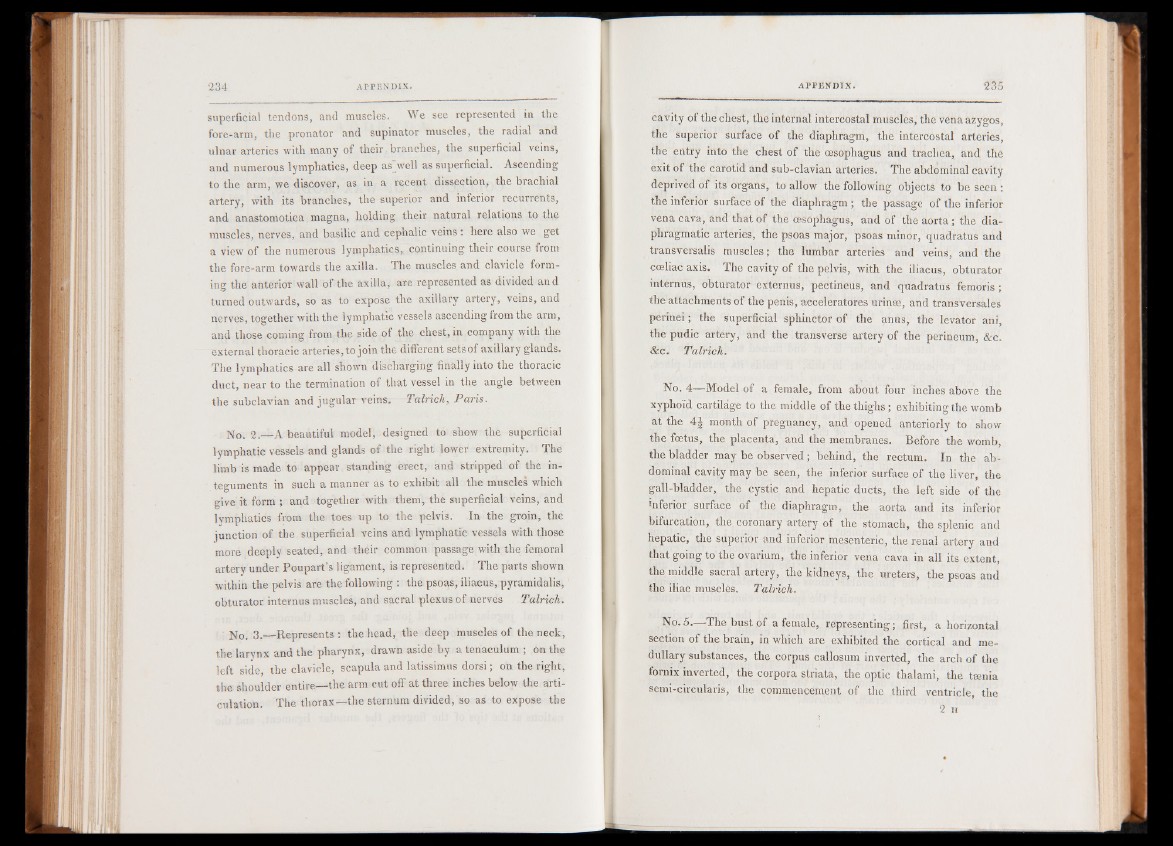
superficial tendons, and muscles. We see represented in the
fore-arm, the pronator and supinator muscles, the radial and
ulnar arteries with many of their branches, the superficial veins,
and numerous lymphatics, deep as well as superficial. Ascending
to the arm, we discover, as in a recent dissection, the brachial
artery, with its branches, the superior and inferior recurrents,
and anastomotica magna, holding their natural relations to the
muscles, nerves, and basilic and cephalic veins: here also we get
a view of the numerous lymphatics, continuing their course from
the fore-arm towards the axilla. The muscles and clavicle forming
the anterior wall of the axilla, are represented as divided and
turned outwards, so as to expose the axillary artery, veins, and
nerves, together with the lymphatic vessels ascending from the arm,
and those coming from the side of the chest, in company with the
external thoracic arteries, to join the different sets of axillary glands.
The lymphatics are all shown discharging finally into the thoracic
duct, near to the termination of that vessel in the angle between
the subclavian and jugular veins. Talrich, P aris.
No. 2.—A beautiful model, designed to show the superficial
lymphatic vessels and glands of the right lower extremity. The
limb is made to appear standing erect, and stripped of the integuments
in such a manner as to exhibit all the muscles which
give it form ; and together with them, the superficial veins, and
lymphatics from the toes up to the pelvis. In the groin, the
junction of the superficial veins and lymphatic vessels with those
more deeply seated, and their common passage with the femoral
artery under Poupart’s ligament, is represented. The parts shown
within the pelvis are the following : the psoas, iliacus, pyramidalis,
obturator internus muscles, and sacral plexus of nerves Talrich.
No. 3.—Represents : the head, the deep muscles of the neck,
the larynx and the pharynx, drawn aside by a tenaculum ; on the
left side the clavicle, scapula and latissimus dorsi; on the right,
the shoulder entire—the arm cut off at three inches below the articulation.
The t h o r a x —-the sternum divided, so as to expose the
cavity of the chest, the internal intercostal muscles, the vena azygos,
the superior surface of the diaphragm, the intercostal arteries,
the entry into the chest of the oesophagus and trachea, and the
exit of the carotid and sub-clavian arteries. The abdominal cavity
deprived of its organs, to allow the following objects to be seen :
the inferior surface of the diaphragm; the passage of the inferior
vena cava, and that of the oesophagus, and of the aorta; the diaphragmatic
arteries, the psoas major, psoas minor, quadratus and
transversalis muscles; the lumbar arteries and veins, and the
coeliac axis. The cavity of the pelvis, with the iliacus, obturator
internus, obturator externus, pectineus, and quadratus femoris ;
the attachments of the penis, acceleratores urinee, and transversales
perinei; the superficial sphinctor of the anus, the levator ani,
the pudic artery, and the transverse artery of the perineum, &c.
&e. Talrich.
No. 4—Model of a female, from about four inches above the
xypho'id cartilage to the middle of the thighs; exhibiting the womb
at the 4\ month of pregnancy, and opened anteriorly to show
the foetus, the placenta, and the membranes. Before the womb,
the bladder may be observed; behind, the rectum. In the abdominal
cavity may be seen, the inferior surface of the liver, the
gall-bladder, the cystic and hepatic ducts, the left side of the
inferior, surface of the diaphragm, the aorta and its inferior
bifurcation, the coronary artery of the stomach, the splenic and
hepatic, the superior and inferior mesenteric, the renal artery and
that going to the ovarium, the inferior vena cava in all its extent,
the middle sacral artery, the kidneys, the ureters, the psoas and
the iliac muscles. Talrich.
No.5.—The bust of a female, representing; first, a horizontal
section of the brain, in which are exhibited the cortical and medullary
substances, the corpus callosum inverted, the arch of the
fornix inverted, the corpora striata, the optic thalami, the tsenia
semi-circularis, the commencement of the third ventricle, the
2 ii